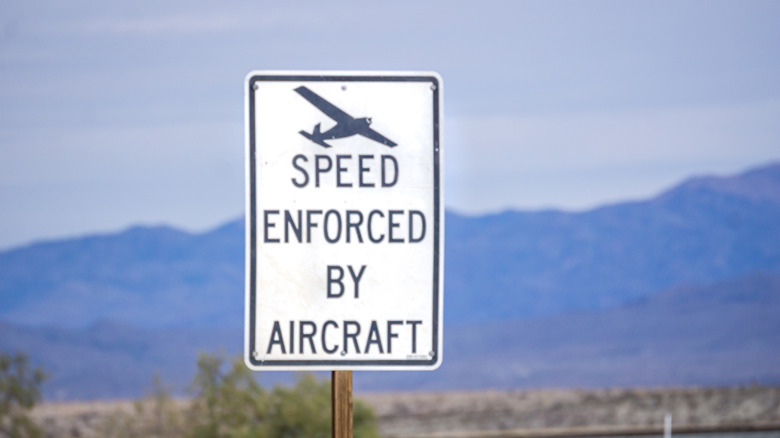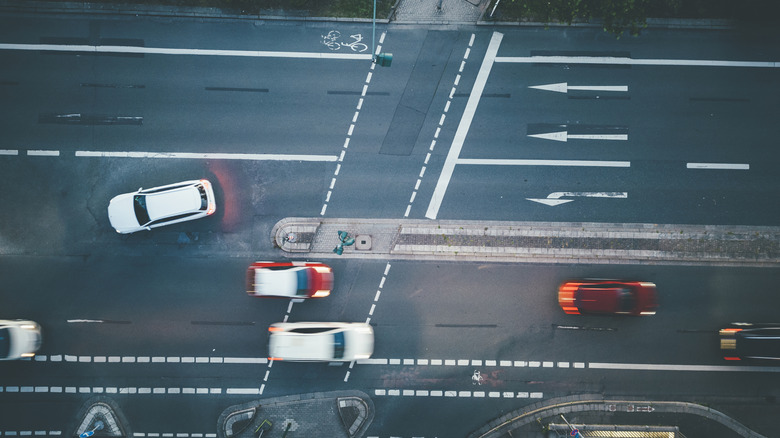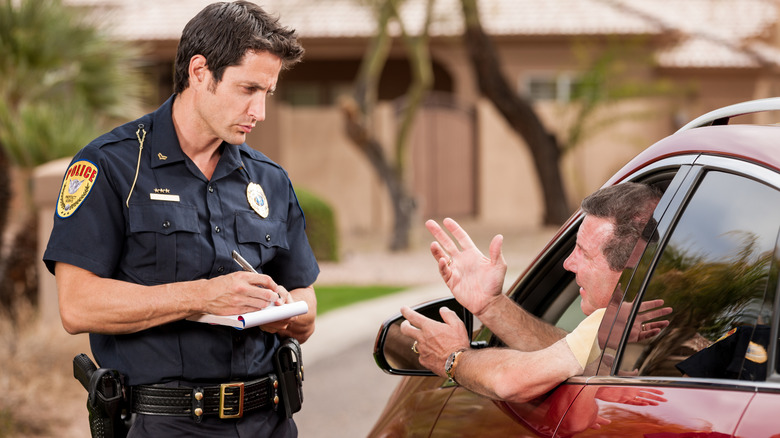How Serious Are Those 'Speed Enforced By Aircraft' Signs, Really?
The use of speed guns and speed cameras to prosecute speeding drivers is nothing new. However, not so widely known is the use of aircraft to clock speeding drivers. But just how seriously should you be taking this? And how widely deployed are they? First, let's state categorically that such speed traps do exist and prosecutions have resulted from information supplied by speed-limit enforcement aircraft. Typically, these aren't high-tech planes crammed with clever technology that captures speeds to fractions of a mile per hour. Rather, they use the old school method of two painted white lines and a stopwatch. It isn't something new to police forces either, with some states — including Colorado — having used such systems for over five decades.
For police forces, the use of airplanes allows them to discreetly monitor driver behavior. Once a speeder is noted by the airborne officers, the pilot radios waiting patrol cars with the necessary details. This includes the description of the vehicle, its location, and details of any traffic surrounding it. The pilot will continue to observe until he can confirm with his ground-based colleagues that the correct vehicle has been pulled over. There are no official nationwide statistics, but we know Florida delivers around 38,000 speeding tickets annually through this method. For comparison, in 2023, there were over 683,000 speeding tickets issued in the state.
From stopwatches to GPS: how it works
The use of stopwatches might seem somewhat crude, but it's a simple method that requires no additional hardware. The latter is important as the cost of running these planes restricts their use. Airborne troopers simply need to monitor marks that are a fixed and known distance apart. The stopwatch is used to time how long it takes a vehicle to cover the distance, and from this point on, it's simply an exercise in arithmetic. For example, if the markers are a quarter-mile apart, a car travelling at 60 mph would take around 15 seconds to cover the distance; a car that covers the distance in 12 seconds is travelling at 75 mph. But this old-school method may be set to be replaced.
Despite the additional costs, some police forces are switching to more advanced aircraft-borne methods of clocking speeding drivers. In Ohio, for example, aircraft are being equipped with Vehicle Speed Measurement (VSM) devices. These devices use cameras and GPS technology to catch speed-limit violators. The system uses the camera to track a driver while the GPS displays where the camera is looking on the mapping system. This system eliminates the potential errors from reaction-time errors, but it also means that the restriction of using pre-marked road sections is negated. Instead, the system is calibrated to use any known quarter-mile traffic location. However, the question remains, just how seriously should these signs be taken? Especially as tools like police radar detectors and apps that warn you about speed traps aren't effective against this method.
Aerial enforcement: myth, deterrent, or real threat?
For drivers with a "leaded" right foot, the question is — should I be keeping an eye on the sky? The sensible answer to this is not to speed, and if you do, it's probably a better idea to keep both eyes on the road. The truth is, aircraft enforcement does happen, but not everywhere, and not all the time. Some states are far more active in this respect than others, and police planes are in high demand for other tasks like searching for missing persons, identifying marijuana farms, and tracking crime suspects. In New York State, despite the presence of aircraft enforcement signs, the system hasn't been used since the late 1990s.
Other states do still use the system. Ohio police, for instance, announced recently that motorists should expect to see an increased use of aircraft to discourage speeding. The department is also in the process of updating all its aircraft to more advanced VSMs. Colorado State Patrol uses two Cessna 182 aircraft that "periodically" fly on traffic missions. However, these mostly patrol the eastern part of the state only. Other states with active programs include Florida, California, Iowa, and Texas, which is also the state with the highest speed limit. So, while the threat of being caught speeding from a plane or helicopter is real, it's far more variable than those warning signs suggest.


